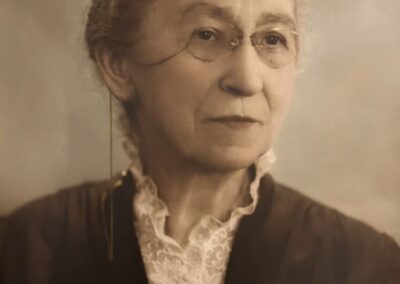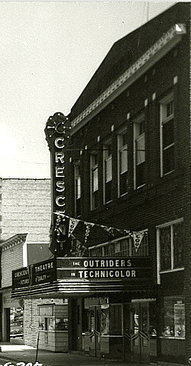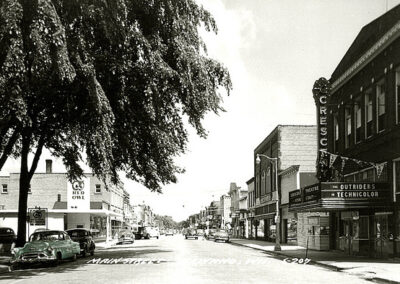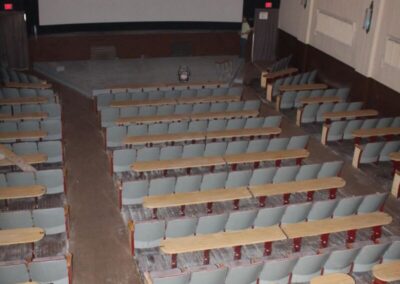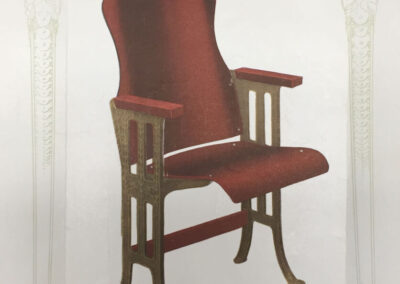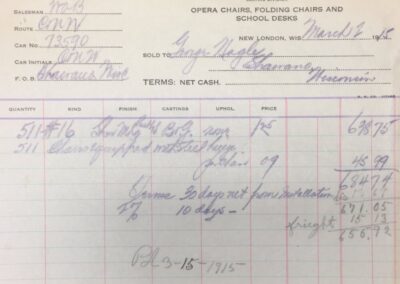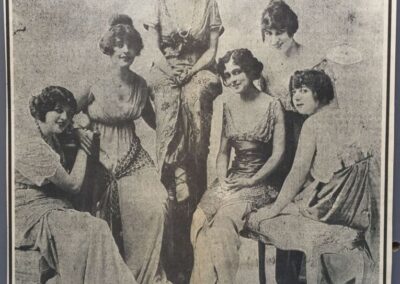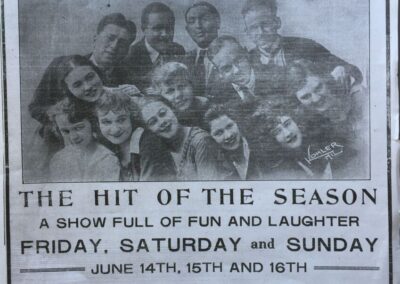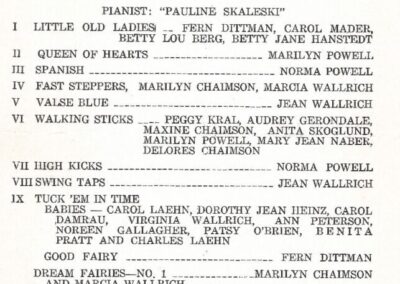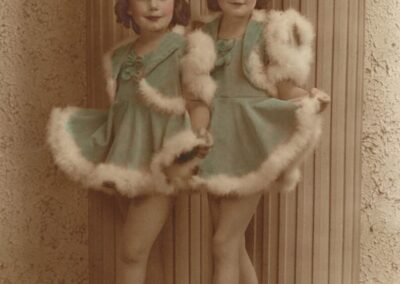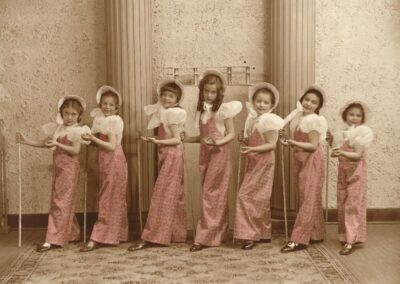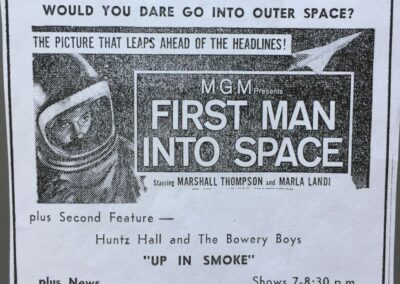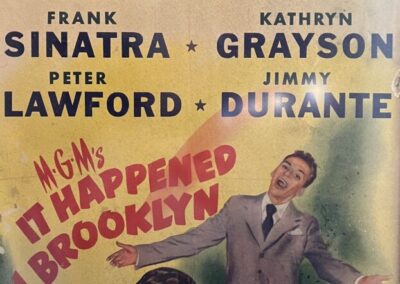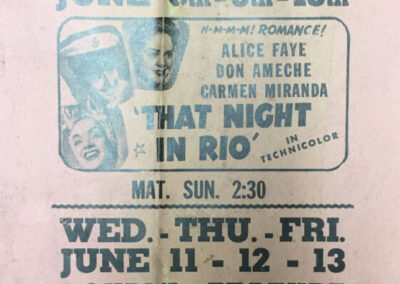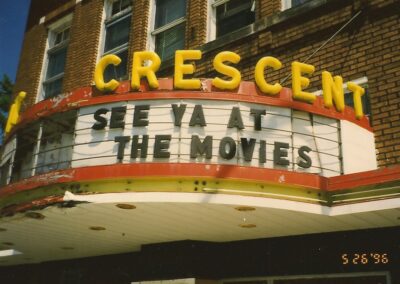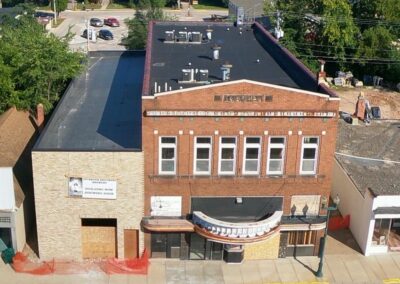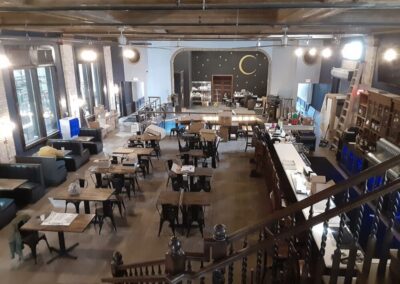Location
Photo Gallery
March 2, 1915 invoice from the Wisconsin Seat Company to Anna Nagle for teh seats installed in the Crescent Theater
A Brief History
The Nagle Building
220 S. Main Street
Shawano, Wisconsin
George and Anna Nagle came from Rhinelander and bought the 220 S Main Street property from F. D. Naber. The Nagles planned and built the Crescent Theater in 1914 and held the grand opening on March 1, 1915. The building, designed by Wausau architect H.T. Leibert and constructed by Shawano builder Fred Werbelow, included both film equipment and a shallow stage, suitable for vaudeville acts but not for full-scale dramatic productions. At its opening on March 6, 1915, the theater showed several motion pictures, featuring such topics as a candy plant in Milwaukee. This was a “state of the art” theater with all the latest technology and comforts. Live Vaudeville and other entertainers were the primary attraction with silent movies shown only on “special occasions.” During construction, Anna and George Nagle bought the 511 seats from the Wisconsin Seating Company in New London, WI. The Nagles received an invoice on March 2, 1915 and paid the company the total of $655.22 for the 511 seats, freight, and installation on March 15.
Anna Nagle, a prominent business woman in the community, had a policy of keeping pace with changing times. Always interested in comfort for her customers, Anna added wider seats, reducing the capacity to 463. She was always upgrading the technology and the appearance of the theater. Over the Nagle tenure, improvements included; a new marquee, candy shop with a state of the art popcorn machine, air conditioning, and equipment for “talkies.” The impressive marquee was installed by Ben Poblocki and Sons of Milwaukee.
Independent Theaters Company bought the Crescent from Anna Nagle in the early 1950’s after decades of operation. William L. Ainsworth, president of Independent Theaters also added the Shawano Drive-In at the corner of Highways 22 and 187. Russell Robbins operated both until they were sold to John and Elenor Reilly in the late 1950’s.
The Reillys owned the theater until Paul Routhieaux bought the property in the 1996 and changed the approach by offering more food choices, beer, and a 2nd run movies. After 17 years, Routhieaux closed the Crescent Pitcher Show in early December 2013 because movies were moving from film to digital distribution technology. Upgrading the theater technology was estimated at $50k at the time which was simply too costly.
220 S Main Street sat vacant until the “Stubborn Brothers,” Aaron and Erik Gilling, took over the property in 2016. After extensively reworking the entire building but staying true to the original architectural design and period, the Nagle Building is now transformed and reinvented. Thank you to the Stubborn Brothers for respecting the history of the property.
Take a look at the photo gallery showing the Nagle Building and Crescent Theater through the years.
AT THE AGE Of 89, Mrs. Nagle Is Still Active in Theatre Business
Shawano Evening Leader article, January 26, 1960
The city of Shawano can claim not only the oldest feminine theatre owner and operator in the state, but also the oldest that is still the most active in Wisconsin.
She is Mrs. Anna Nagle, owner and the operator of the Crescent Theatre here, who will celebrate her 90th birthday on October 24.
Mrs. Nagle, who is still very active in the operations of the local theatre, does her own book-keeping, banking and all the other work which goes into the successful operation of the movie house which was built here by her late husband in 1915. She has carried on year after year since the death of her husband George in 1916, just a year after the theatre was built. Under her direction the Crescent has operated continuously without closing for 45 years, with the exception of probably a few days while modernization improvements were being made.
“I can remember like yesterday the first stage shows that appeared here,” Mrs. Nagle remarked as she told the story about the tremendous transition which took place in the movie world from the times of the traveling stage shows and silent movies to the present stereophonic movies on the large screen in color.
The theatre was originally designed for stock shows which traveled throughout the country playing sometimes for two-three day stands and sometimes more, depending on the reception given in each town. There was the familiar orchestra pit below the stage, curtains operated by hand that sometimes dropped with a thud and other stage equipment which was all manually operated.
A year after the stage shows bowed out came the silent movies. The film came complete with sheet music which was played by local pianists to set the mood for the film showing. Pre-movie time entertainment was furnished by local orchestras.
“I recall the days when Blanche Gale, now Mrs. David Winter of Shawano, and Gertrude Wallrich played at the theatre just a few years after we started,” said the operator who also noted they were fine artists at the piano along with several others that she just could not name.
Mrs. Nagle was born at Beaver Dam, Wisconsin and with her husband operated a general store at Rhinelander when they got the idea to build a theatre. They traveled through this section of Wisconsin and finally decided on Shawano as a site and built the theatre here which is the original building
The Crescent has been re-seat-ed three times since the first opera seats were installed back in 1915 and the modernization work was completed as the times demanded. The theatre seats less than it did back in 1915 due to the modern, larger and more comfortable seats installed. The upstairs was originally used as a dance hall and meeting room for various organizations before the city had a community hall.
At the age of 89, Mrs. Nagle is still very active and in good health. In addition to her lengthy day-by-day tasks of operating the Theatre, she attends Sacred Heart Church every Sunday and attends meetings of the Sacred Heart Missionary Society and The Christian Mothers Society when she can break away from her business.
“I’m not ready to retire yet, I’ve still got a few more good years left,” which is quite a statement for a lady of almost 90 to make.
Her hobby is reading, taking a keen interest in local and state affairs and she keeps up to the times on the theatre by reading five trade journal magazines each week.
Forty-five years in business for a lady of her age is an accomplishment seldom equaled-may she have many more.
From the 1999 National Register of Historic Places Registration application:
The only historic theater in downtown Shawano, this building has excellent overall integrity. Two stories in height and constructed of load-bearing brick, the theater has a slight false gable rising above the roofline, and a simple, molded, pressed-metal cornice underneath. The area between these two features is marked at the center by an inset, pressed-metal plate bearing the name of the original owners of the theater, flanked on either side by smaller inset panels with the date of construction, which is split in half with two digits on either side of the name plate.
Beneath the cornice are six one-over-one, double-hung windows, each surmounted by a three-light transom. The windows rest on a continuous concrete sill that extends slightly beyond the end windows. Each window is surrounded by a slightly raised brick frame with square white concrete accents at the upper comers of the surround. The four windows at the center share the vertical elements of these frames between them. The single window at either end is slightly set apart from the rest and independently framed. A slightly raised brick panel with shallow corbels projects from immediately under the continuous second story window sill described previously.
The storefront area of the theater has a predominately intact, black structural glass surround applied during the late 1930s. The upper portion of this facade is marked by a projecting marquee dating from the early 1950s; windows to either side were blocked with siding at approximately the same time. At the center of the facade at the ground floor is a narrow one-person ticket booth which projects from the facade in a semi-hexagonal shape. It is sheathed in black structural glass and has the historic name of the theater etched in Art Deco-Style lettering above the booth window. With the exception of one broken glass panel at the base of the ticket booth, this feature is entirely intact.
The booth is flanked to the south by three narrow doors consisting of wide oak frames surrounding a three-quarters length, plate glass window; the remainder of the lower portion of the door being covered by an aluminum kickplate. Each door has a pair of round aluminum bars placed at arm level to allow patrons to push the door open; these are set at a slight angle so that the two southernmost doors, which are hinged to face each other, have slightly inclined push bars that meet in the middle, forming a shallow chevron shape when closed. The third door is separated from the other two by its frame and its push bars are set at the same angle, rising toward the ticket booth at the center. The single historic door on the opposite side of the ticket booth is a mirror image of the door previously described; a pair of matched doors on this side, presumably identical to those described, were replaced in recent years by a non-historic door and sidelight installed to permit wheelchair access to the theater’s lobby. An inset doorway leading to the second floor adjoins the storefront pier adjacent to the door described on the northerly end of the facade, while the window at the southerly end, beyond the historic set of doors, which historically functioned as a small confectionery stand, has been covered with painted plywood. The interior of the theater has undergone some alterations; Art Deco sconces and chandeliers do remain from the late 1930s renovation. The original shallow stage is still extant, as are many of the original metal theater chairs.

